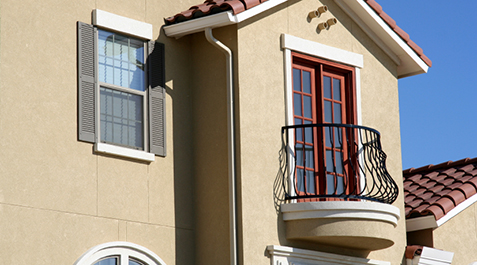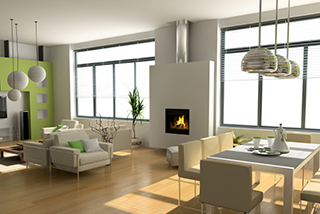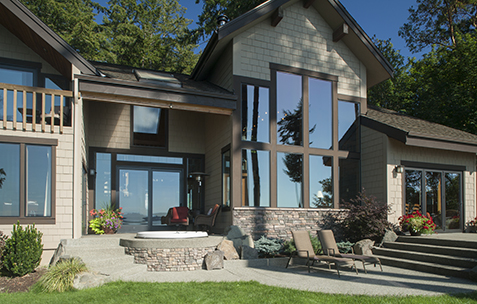- Contact Us Today
- Sacramento (916) 476-8396
- Carmichael (916) 978-1041
7 Tips for Selecting a Window Frame Color

By Interior designer and color expert Jennifer Ott
Whether you are building a new home or taking on a renovation, the number of choices you have and decisions to make throughout the process often seem endless. Selecting windows alone can be a formidable task. And just when you've nailed the perfect window size, type, and style, you find you have one more choice to make—color—specifically the window frame color. Many homeowners start to feel overwhelmed at this point. Do you go with something neutral and tried and true, or should you be a bit more adventurous? And how do you then coordinate the window frame color to your house color? Here are some tips to help you navigate selecting a window frame color.
Many homeowners start to feel overwhelmed at this point. Do you go with something neutral and tried and true, or should you be a bit more adventurous? And how do you then coordinate the window frame color to your house color? Here are some tips to help you navigate selecting a window frame color.
1. Use Color as a Tool to Enhance (or Disguise)
Generally speaking, you want to showcase nice windows and hide ugly ones. I advise homeowners to downplay worn or otherwise unattractive windows by painting the frame and trim white or a hue that allows them to blend in with the surrounding wall or siding color. But if you are purchasing new Milgard windows think about selecting a frame color that will make your new windows stand out, especially if yours is an architecturally interesting home.

2. Work with Your Décor
If your design style veers toward traditional, consider window trim colors that contrast with the house color. For example, try pairing Milgard's Essence Series color Cinnamon with a medium taupe house color for a colorful update to a traditional palette.

An upstairs house porch
Fans of modern and contemporary design will want a look that is less busy and ornamental, and should go for window trim colors that blend in with th surrounding wall color. Try pairing Milgard's Premium Exterior Vinyl in Silver with a similar gray house color that is a few notches lighter or darker, for a clean, contemporary look.

3. Use Bold Hues Wisely
Keep in mind that it's relatively easy and affordable to change paint colors, unlike windows—which are a much bigger investment. For this reason I generally advise homeowners to pick a neutral hue for their window frames. Then, if you like fun, bold colors, you can go to town with your paint colors. Of course for every design rule of mine I am always looking for opportunities to break it.

There's something to be said for going for the unexpected—doing things a little differently from everyone else. So if you aren't afraid of color, go ahead and select a bolder hue for your window frames. If you go this route, though, I'd keep the surrounding color neutral, or in a similar color family as the frame. For example a bold window frame color such as Milgard's Essence Series color Pea Pod would look fantastic with a medium-to-dark gray or a dark green house color.
"Gray is having its moment in the spotlight as the new neutral."
4. Consider "New" Neutrals


5. Consider Your Climate and Environment
If you live in an area that gets dusty or dirty easily, such as near a freeway or an active construction site, keep in mind that grays and taupes in mid-tones (i.e. not too light; not too dark) camouflage dirt best. White and other light colors as well as black and dark colors tend to show dust and dirt the most. So your best bet to camouflage dirt and grime is to go with Milgard's Fog or Harmony in the Essence Series or Tan, Silver, or Light Grey from the Premium Vinyl line. Of course if you live in a hot and sunny climate you might want to consider using lighter colors for your window frames as well as on your house. White and light shades won't absorb heat or fade as quickly as darker colors.
"Warmer palettes tend give a more traditional feel while cool palettes feel more modern."
6. Work within a Palette
For those who are easily overwhelmed by the large number of color choices available, a foolproof way to coordinate your window frame and wall and décor colors is to limit yourself to either a warm or a cool palette. A warm palette would include shades of red, orange, yellow, and brown, and your coordinating window frame colors would be Natural Crème, Rattan, Tweed, Cinnamon, Classic Brown, and Bark in the Essence Series and Tan, Espresso, Chocolate, and Taupe from the Premium Vinyl line. A cool palette includes shades of green, blue, purple, and grays and your coordinating window frame colors would be Fog, Pebble, Pea Pod, Fern, and Evening Sky from the Essence Series, or Silver or Light Grey from the Premium Vinyl line. I find warmer palettes tend give a more traditional feel while cool palettes feel more modern. White and black window frame colors work well with all design styles.

7. Get Design Assistance
If you just can't decide what color direction to go in, I suggest browsing through shelter magazines or online (Pinterest and Houzz are good places to start) to find examples of what you like. If you have a friend or family member with a good eye for color and design, you can try enlisting their help—perhaps you can trade services with them. Don't dismiss hiring a design professional to help out either, many designers will take on small consultations jobs for a reasonable fixed fee.
 About the Author:
About the Author:
Jennifer Ott is a San Francisco-based interior designer and color expert who specializes in helping clients make material, fixture, finish, and interior and exterior paint color selections. Website: www.jenottdesign.com
All colors shown are exterior fiberglass finishes on Essence Series® wood windows by Milgard.
Which Color Glass Is Best For Windows?
Many factors go into determining the best type of glass for windows, but most people overlook the importance of color. The right colour can make a space feel open and bright while a dark or opaque shade will close it in. It also depends on if you're looking for something more modern or traditional. The colour of the glass in your window will have a significant impact on your home’s energy efficiency.
Window glass should be colored with bright and vibrant colors. Darker shades make the window frame appear to disappear within it, leaving a smooth effect that is less appealing than brighter coloured window frames. When deciding on the perfect color for your windows, there is a multitude of colors to consider:
No Color, Clear Window Glass Color
- Clear glass is the best choice for homes where sunlight can be less intense, especially those on lower floors.
- Clear glass is a good choice if the interior décor includes dark colors like black or navy. The light reflecting off of clear glass will make those darker shades stand out and create an elegant design that looks both modern and traditional
Blue Window Glass Color
- Blue-colored glass is the best choice for going with white-colored window frames.
- Blue-colored glass isn't just for novelty purposes. It can also serve as an extra layer of protection against UV rays.
Sea Green Window Glass Color
- A green-colored glass pane will add some natural vibrancy and bring out that sense of life in any room! And goes well with white window frames.
- The clean green look of glass panes is often popular among homeowners. A few pros that come with it are its energy efficiency, safety from solar heat gain, and UV light protection, not to mention the fact that they add a touch more natural aspect into your home's interior design.
Brown Window Glass Color
- Brown glass panes are perfect for dark brown window frames, and they will create a pleasant atmosphere in the house.
- The Brown glass panes give the home a vintage feel with better UV ray protection. It's a good idea to install these in the bedroom or office, where we spend most of our time and expose ourselves to more sun exposure than other areas of the house. The downside is that they make your space darker, so it might be best not to use them on windows close by street traffic with bright lights shining through!
What Are Colored Glass Windows Called?
Colored glass windows are called stained glass, and the process of making them is called "stained-glass art." This type of art has been around for centuries. The earliest examples date back to Roman times when craftsmen used a technique known as cloisonné. In this technique, thin strips of lead were applied to frames made from wood or metal before the molten glass was put in place. When it cooled down and hardened, these strips created patterns that shone through the translucent coloring.



